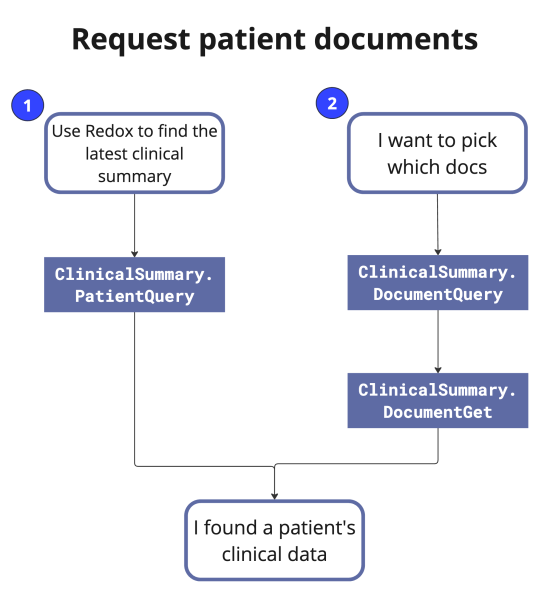After you successfully search and locate patient records at a given organization, you can request patient documents. There are two options for this step.

- Use Redox to request the latest patient summary: Typically, the simplest option is to request a generic patient summary directly via Redox.
- Pick your own docs: If you can select documents of interest within your own UI, you can retrieve a full list of available documents and select the specific documents that are of interest.
The returned documents from either option follow a standard format (Consolidated-Clinical Document Architecture, or C-CDA) and include several sections of information related to the patient’s demographics, encounters, medications, diagnoses, allergies, and more. Check out required C-CDA elements.
Choose this option if you only want CDA documents, and you want to automatically get the most recent CDA for a patient. You receive the data back in a nice Redox-parsed view.
This option relies on the ClinicalSummary data model.
- Using Postman or curl, send a ClinicalSummary.PatientQuery request with the relevant metadata, like the patient’s ID and ID Type (from the PatientSearch response) and the organization OID (which goes in the Meta.FacilityCode field).Example: Request a patient summarybashAPI reference
- If the request is successful, you receive a synchronous ClinicalSummary.PatientQueryResponse with the latest patient summary document (i.e., a snapshot of the patient’s current chart).Example: Successful response for a patient summaryjson
Choose this option if you want to receive a full list of documents related to the patient. Then, query for any document from the list. You receive the document in both raw XML—which is useful if you have your own document renderer—and in a Redox-parsed view for any data that we can parse.
For this option, use the DocumentQuery and DocumentGet event types of ClinicalSummary. The response returns PDFs or any other documents that are attached to the patient record.
- Using Postman or curl, send the ClinicalSummary.DocumentQuery request with the relevant metadata:
- Patient ID and ID Type: These values are returned in the PatientSearch response.
- Organization OID: The organization OID is equivalent to the HCID value (from the DocumentQuery response) and should go in the Meta.FacilityCode field of your request.Getting documents of valueExample: Search for a document list from CarequalitybashAPI reference
- If the request is successful, you receive a synchronous ClinicalSummary.DocumentQueryResponse with a document list with an identifier, type, and date for each document so that you can identify the most relevant documents.Example: Successful response for a document list from Carequalityjson
- Using Postman or curl, send the ClinicalSummary.DocumentGet request with the relevant metadata, like the document ID and type (from the response in the previous steps) and the organization OID (which goes in the Meta.FacilityCode field).Less is moreExample: Retrieve a document from Carequalitybash
- If the request is successful, you receive a synchronous ClinicalSummary.DocumentGetResponse with the relevant document of interest.What format to expectExample (abbreviated): Successful document retrieval from Carequalityjson